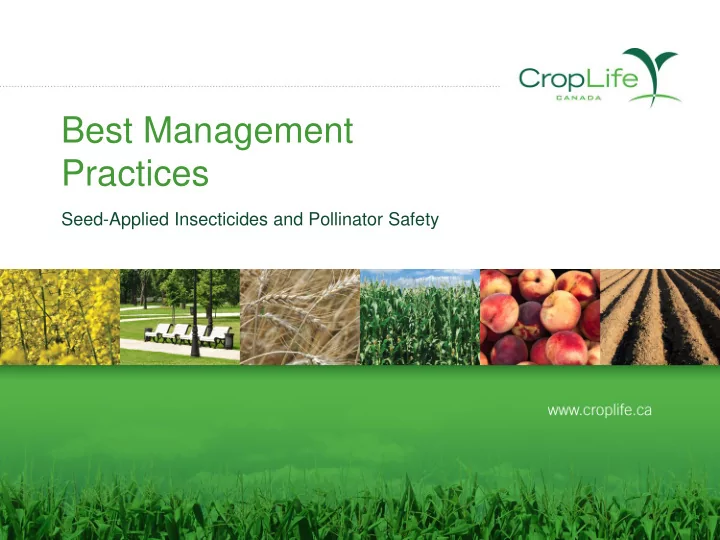

Best Management Practices Seed-Applied Insecticides and Pollinator Safety
Introduction • This document assembles the present knowledge and understanding around the proper use and handling of seed treated with an insecticide, primarily from the perspective of pollinator safety. • CropLife Canada strives to develop stewardship principles to maximize the benefits and minimize the potential adverse effects of insecticidal seed treatments on non-target organisms. • Best Management Practices (BMP’s) for the proper treatment of seed, and the management of those seeds are key steps in ensuring a sustainable business environment for all involved stakeholders. 2
Integral components of sustainable agriculture • Loss of key crops affects more than just the rural economy • Pesticides help us to use our resources more efficiently • 10% post-harvest 1 out of every 3 mouthfuls of food we eat and beverages we 13% disease drink is facilitated by insect pollination 14% weeds • ~70% of top 100 food and fibre crops rely on insect pollination 15% insects • ~90% of wild plants use insect pollination for reproduction, Average % losses without underscoring their role in promoting biodiversity crop protection products 3
Seed Treatments • Seed treatments, while discovered hundreds of years ago, have been used routinely in agriculture for a century, and in Canada since the early 1950s • Seed treatment is a targeted approach to pest control, consistent with IPM • The success and popularity of seed treatment is still growing and evolving 4
Status of Honey Bees in Canada • Influenced by a number of challenges – Has resulted in higher than normal overwintering losses in Canada and around the world • Varroa is ranked the highest risk for, and contributor to, failing hive health • Risk = hazard X exposure – In the absence of exposure, there is no risk • Pollinators can be exposed to pesticides in a number of different ways (drift, dust) • Neonicotinoid insecticides have not been shown to contribute to chronic bee declines 5
Seed Treatment Technologies • Seed treatment formulations have components that make the active ingredient adhere to the seeds without impeding their flow or planting characteristics • Companies are providing new platforms for improvements to existing seed treatments Finishing layer Colourant Seed core Coating layer(s) Insecticide Fungicide(s) 6
Best Management Practices for Growers • Treated corn seeds contain pesticides and need to be handled with care, as per the info on the tag • Dust can be generated in a number of different ways – During manufacturing, transport and storage, and even during preparation and planting operations • Communication between beekeeper and grower is critical for reducing exposure risks – sharing of hive locations, timing of agronomic operations 7
Best Management Practices for Growers • During seeding, reduce dust exposure by: – not shaking the seed bag – using planter box lubricants correctly – covering any exposed seeds – cleaning up any spills – being aware of weather conditions (especially wind direction) – by removing flowering plants from the target field 8
Corn Planting Equipment • Some vacuum planters exhaust to the environment, not the soil surface • In some European countries, the use of dust- deflector retrofit kits has been investigated to conduit air and dust to the ground • While shown in many situations to reduce potential exposure of pollinators to fugitive dust, questions still remain • Appropriateness of this technology to North American planters is being evaluated 9
Corn Planting Equipment Corn Planting Equipment: • Modifications may not be suitable for all equipment and may result in unintended results, such as: – Downward deposition onto flowering weeds in the field to be seeded – Negative impacts on the operation of the planter • Speak to your equipment dealer or manufacturer regarding the status of the development of deflector kits for North American vacuum planters 10
Recommend
More recommend